Commodities – The Bull Market You Aren’t Hearing About
Over the past several months, these pages have been littered with concerns about inflation re-appearing. Much like recessions and pandemics, we never really know precisely when inflation might happen. This inability to predict markets is at the heart of our investment process. The world is unpredictable, so we don’t base our decisions on predictions. Instead, we prepare by creating a balanced portfolio with the expectation that the risks of one asset class are mitigated by another. This is the core of portfolio diversification/risk reduction.
Traditional portfolio construction includes stocks and bonds, but in our experience, gold and other commodities are only occasionally used in portfolio construction. Academic research has identified commodities as a strong portfolio diversifier, but commodity investment has never become common. As a firm, PWM portfolios contain commodities and gold as core investments.
We believe that one of the reasons that commodities are less common in investment portfolios is that they tend to run in long cycles and staying disciplined in long cycles can be very difficult. The last big commodity cycle lasted from roughly 2000 to 2014. This was almost entirely driven by demand from emerging markets, in particular China, and overlapped with concerns about long term supply. This followed a commodity bust in the 1980’s and 1990’s. From 2015 to 2020, we were back into ‘bust’ mode, driven by lower oil prices, a diminution of foreign commodity demand, and aggressive expansion of global production capacity in response to the prior boom.
Although the cycle is long, commodity markets are no different than other markets in the sense that they anticipate the future. We have been discussing the threat of rising inflation for the last several months and the financial press was full of inflation stories over the last week. Whatever you might read, the charts on the following page are the evidence – commodity prices began to rise at the peak of the first wave of the COVID pandemic last Spring. These commodities are core building blocks for most everything we need, so price increases at this level eventually carry over into the goods we buy. Commodity prices may be signaling that the inflation the FED has been trying to create for the last 10+ years, might finally be here.
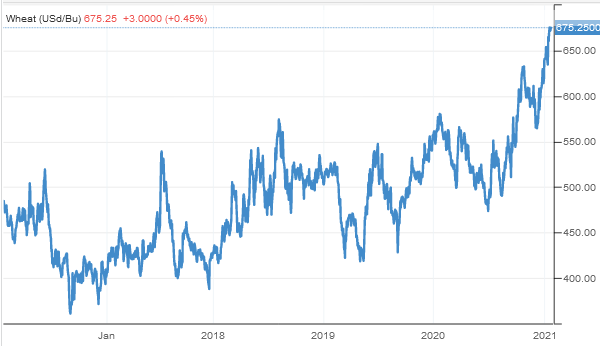
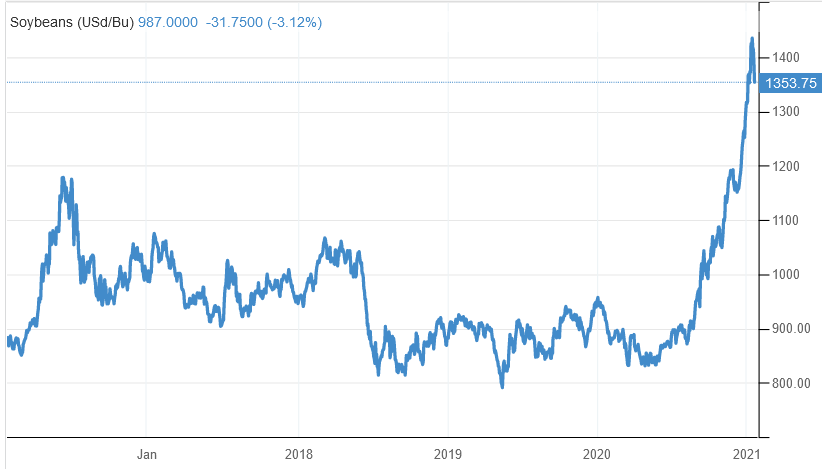
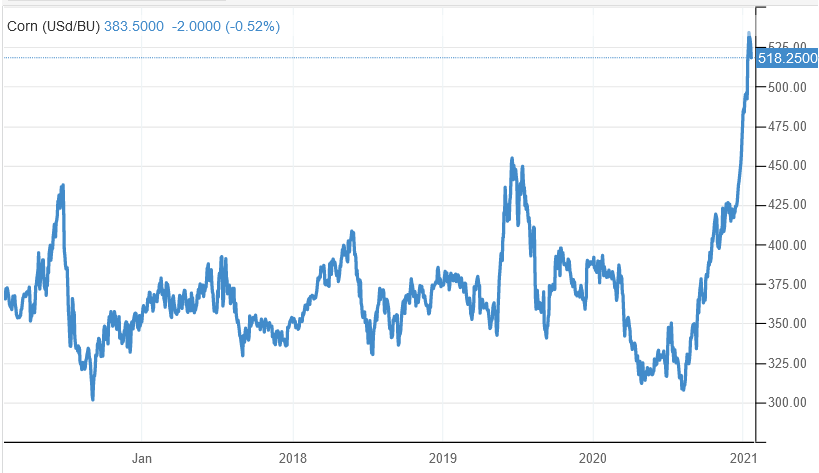
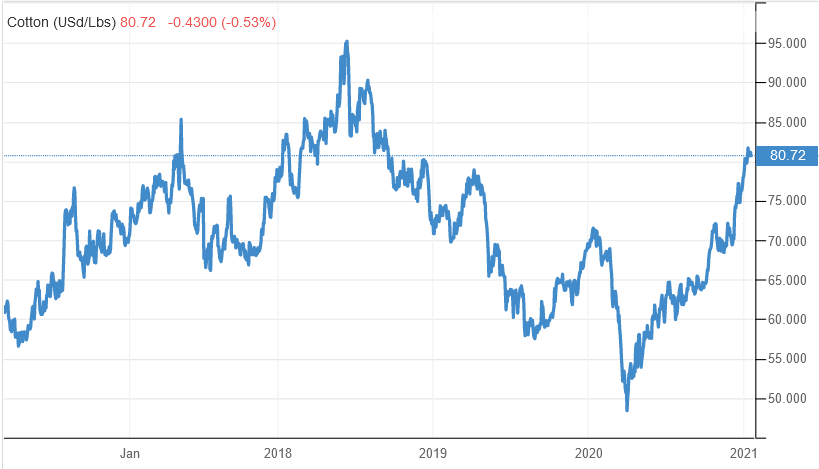
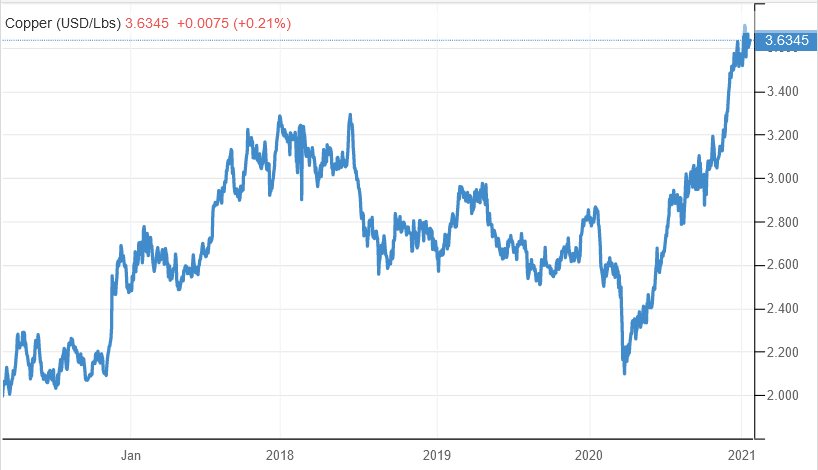
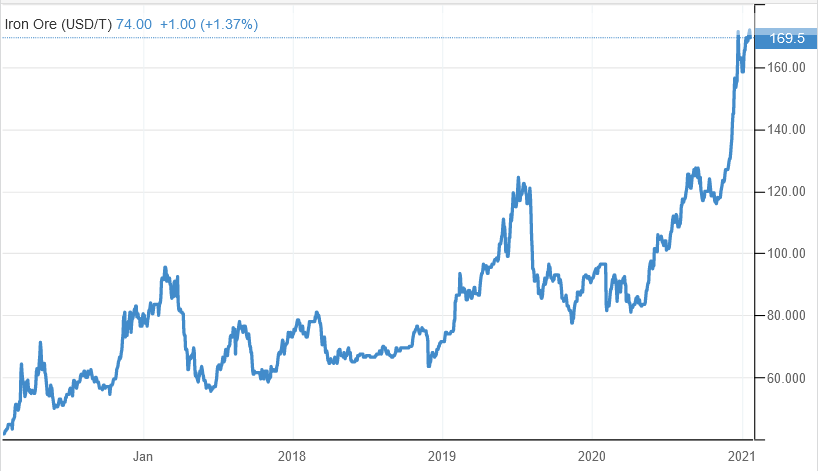
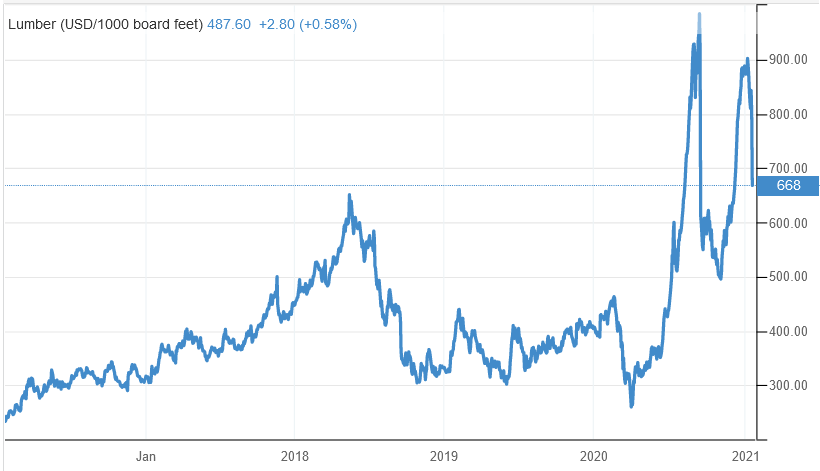
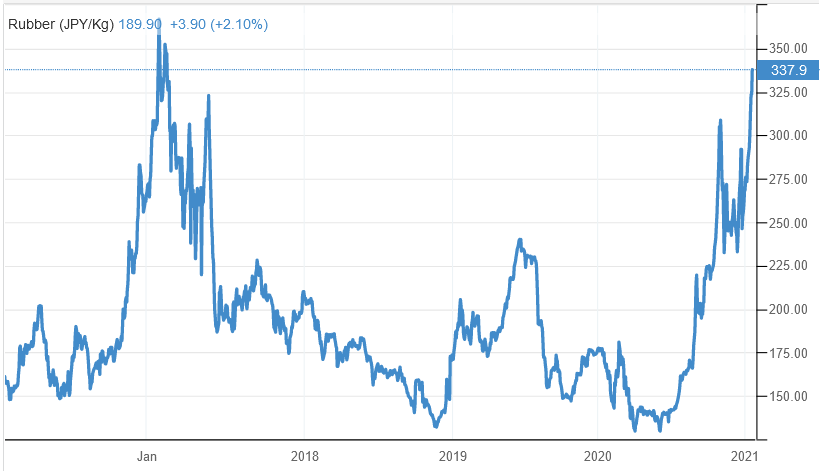
Source for all charts is Trading Economics
Looking at the charts above, there is some evidence that the next great cycle in commodities may be starting. Since the cycle low in March of 2020, commodities have been taking off. Certainly, some recovery from the pandemic-induced demand cliff is to be expected, but what we view as noteworthy are 1) many of these prices have already exceeded pre-pandemic levels, despite aggregate demand not yet returning to normal; and 2) there has been a broad recovery across base metals and agricultural products, suggesting that the rise in commodity prices is due to something more than the recovery from the pandemic.
As we discussed last week, the pandemic catalyzed a jolt of fiscal stimulus to the economy and fiscal stimulus has a much greater impact on the real economy than the monetary stimulus that has been with us since the Great Financial Crisis of 2007-08. This next round of massive fiscal spending from Congress may finally deliver the inflation that the FED has been attempting to create for 10+ years. We just need to be careful that it doesn’t become too much inflation, because that is a slippery slope.
Jobs, Automation and the Minimum Wage
One of the biggest problems with political solutions is that politics desires a simple, logical sounding response that can be easily marketed to voters. Unfortunately, it is extremely rare that such solutions give any thought to unintended consequences. We saw that again this week in an article by the Financial Times. In that article, the author reviews 100+ years of history that suggest that a higher minimum does not impact employment. We see that as the first problem. The author assumes that the next 10, 15 or even 100 years will look like the last 100 years. We like to use history as a guide, but we don’t take it as gospel.
The author then goes on to identify the next culprit that will hurt low wage earners – contract employees. According to the author, a higher minimum wage is often offset by less spending on overtime, and the way that is accomplished is by using contract labor. This allows a company to actively scale its labor force to demand, but it also eats away at the benefits of full-time work, in particular, job security. The author suggests that in addition to the minimum wage, President Biden “should push for a floor on conditions as well as hourly wages, curbing those practices that drive down labour costs by increasing worker insecurity.”
So, the ‘solution’ is to raise the minimum wage and reduce the ability to circumvent that increase. If only it were that simple. What is completely missed in the article is the impact of technology, specifically AI and automation. An MIT study last year found that technology has improved the efficiency and productivity of skilled workers, but has begun to replace workers in low skill jobs. Automation and artificial intelligence are coming no matter what the minimum wage is, but a higher minimum wage simply makes automation a more enticing economic proposition than it already is.
This is a much larger issue than the minimum wage. The MIT study suggests that technology advances initially were a huge boost to productivity, which was a great economic benefit. Yes, jobs were lost as a result, but ultimately new jobs more than replaced those lost jobs. However, the pace of technology advancement hit an inflection point in 1987. Since then, we have been unable to completely offset job losses with new job gains. The article states “Within industries adopting automation, the study shows, the average “displacement” (or job loss) from 1947-1987 was 17 percent of jobs, while the average “reinstatement” (new opportunities) was 19 percent. But from 1987-2016, displacement was 16 percent, while reinstatement was just 10 percent.”
A higher minimum wage may be a great political sound bite, but the evidence suggests that it will be unsuccessful in dealing with the core problem, which is integrating technology into the workplace and re-training those left behind with new skills that have value in a rapidly changing world. Unfortunately, there are no easy, political answers for that problem. (For an opposing view, see the link “Why the $15 minimum wage is pretty safe” below.)
What We’re Reading
As COVID-19 Vaccines Emerge, the Search for Antiviral Drugs Continues
Biden Targets Trump’s Legacy with First-Day Executive Actions
Fleeing the City? You’ll Be Back
More Than Precious: Silver’s Role in the New Energy Era
Why the $15 Minimum Wage is Pretty Safe
Cooperman Sees ‘Euphoria’ in Parts of Market; Skeptical on Long-Term Outlook
Grey Areas in the Green Revolution (FT – Subscription may be required)
Yellen’s Call to ‘Act Big’ Reflects Long Re-think on Big Government Debt
How Biden Plans to Tackle the $1.6 Trillion Student Loan Debt (6 Min. Video)
Bond yields are rising. Why does it matter?
Retirement Planning:
Should You Pay Off Debt or Save For Retirement?
It’s the Coke vs. Pepsi debate of personal finance. When you have extra money at the end of the month, should you pay down debt or bulk up your retirement savings?
Tax Planning:
First Time Investors, Here’s What You Need To Know About Taxes
Investing for your future and for your retirement is one of the most important things that you can do. But the impact of investing on your taxes can also be uncertain.
Estate Planning:
Why an Irrevocable Trust Might Be the Right Estate Planning Tool
Unlike a revocable trust, assets contributed to an irrevocable trust no longer belong to you. If the thought of losing control may be of concern to you, think about the benefits of doing so.
Health:
The Benefits of Brief Bursts of Exercise
Doing vigorous exercise for just 12 minutes triggers changes in blood levels of substances linked to cardiovascular health.
Entrepreneur:
Five Mistakes New Entrepreneurs Make
Have you ever wondered why many entrepreneurs fail? It is normal that everyone wants to taste the honeys of entrepreneurship, but not everyone is willing to pay the price.
Disclosures:
Palumbo Wealth Management (PWM) is a registered investment advisor. Advisory services are only offered to clients or prospective clients where PWM and its representatives are properly licensed or exempt from licensure. For additional information, please visit our website at www.palumbowm.com
Past performance may not be indicative of future results. Different types of investments involve varying degrees of risk, and there can be no assurance that the future performance of any specific investment, investment strategy, or product made reference to directly or indirectly in this newsletter, will be profitable, equal any corresponding indicated historical performance level(s), or be suitable for your portfolio.
The information provided is for educational and informational purposes only and does not constitute investment advice and it should not be relied on as such. It should not be considered a solicitation to buy or an offer to sell a security. It does not take into account any investor’s particular investment objectives, strategies, tax status or investment horizon. You should consult your attorney or tax advisor.
The views expressed in this commentary are subject to change based on market and other conditions. These documents may contain certain statements that may be deemed forward‐looking statements. Please note that any such statements are not guarantees of any future performance and actual results or developments may differ materially from those projected. Any projections, market outlooks, or estimates are based upon certain assumptions and should not be construed as indicative of actual events that will occur.
All information has been obtained from sources believed to be reliable, but its accuracy is not guaranteed. There is no representation or warranty as to the current accuracy, reliability or completeness of, nor liability for, decisions based on such information and it should not be relied on as such.
Asset Allocation, Asset Classes, Automation, Commodities, Copper, Corn, Cotton, Federal Reserve, Financial Times, Gold, Inflation, Iron, Jobs, Lumber, Minimum Wage, MIT, Portfolio Diversification, Rubber, Soybeans, WheatArticles, General News, Weekly Commentary
By: Adam


